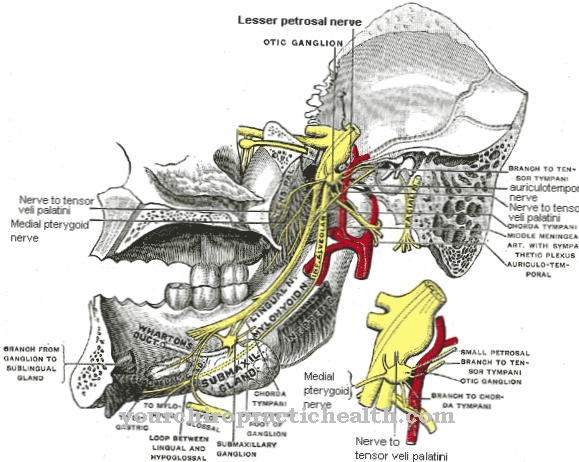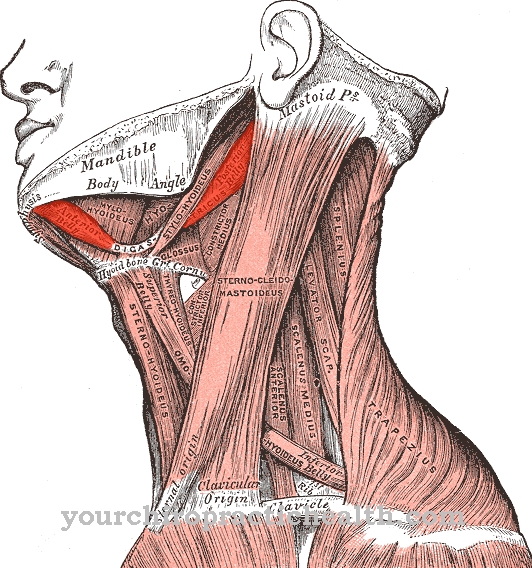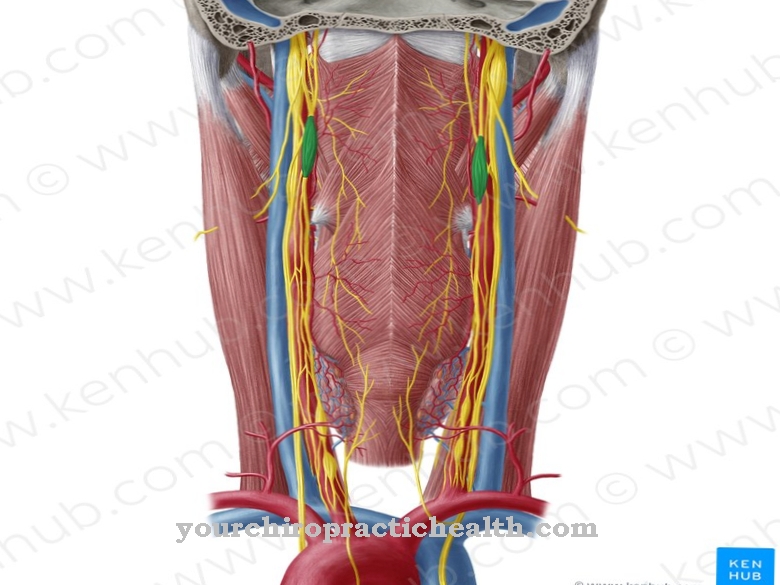Of the Median nerve arises from the arm nerve plexus brachialis, which emerges from the spine between the 6th cervical and 1st thoracic vertebrae (C6 - Th1). The nerve is assigned to the peripheral nervous system and motor and sensory enervates part of the muscles of the forearm and hand including fingers.
What is the median nerve?

The median nerve (middle arm nerve) is assigned to the peripheral nervous system (PNS) and has a double function. Its efferent fibers send sensory impulses to the brain, while the afferent fibers carry motor signals from the spinal cord or brain to the muscles concerned.
The fact that the nerve belongs to the peripheral nervous system means that, unlike the nerves of the central nervous system (CNS), it is not subject to the blood-brain barrier. The excitation lines of the middle arm nerve, consisting of bundled nerve fibers, are - as with all peripheral nerves - encased in 3 layers of connective tissue to protect, supply and give a certain tear resistance.
It branches in its course from the axillary cavity to the underside of the palm in order to be able to supply all muscles for which it is responsible with impulses for contraction or loosening and to report back sensory "data" that are important for vegetative control.
Anatomy & structure
The median nerve arises from the lateral nerve cord of the brachial plexus. It is one of the three large arm nerves and runs from the nerve root in the axillary cavity (median fork) in the upper arm to the elbow. It remains unbranched up to the elbow.
The nerve branches into three branches for the sensory and motor supply of certain forearm muscles, which are mainly responsible for flexion and inward rotation of the forearm. In the forearm it runs - protected by two muscles - between the ulnar nerve and the radial nerve. At the wrist, the nerve migrates under the broad tendon ligament (retinaculum flexorum) through the carpal tunnel into the palm of the hand, where it branches out again in order to enervate certain finger muscles.
The nerve is enveloped by three layers of connective tissue. The endoneurium, the innermost layer, consists of loose connective tissue that contains a large number of blood and lymph vessels to supply the nerve fibers. The overlying perineurium contains tight connective tissue, which is able to bundle many nerve fibers and separate them from one another. Outwardly, the median nerve is enveloped by the epineurium, which, in addition to solid collagenous fibers, can also contain fatty tissue, which provides a certain amount of cushioning and the ability to move.
Function & tasks
As the mixed nerve of the peripheral nervous system, the median nerve has two main tasks. He has to enervate certain muscles of the forearm, the ball of the thumb and the palm of the hand. The corresponding muscles respond to voluntary signals to contract or relax, which are transmitted from the median arm nerve to the muscles.
Specifically, the median nerve is responsible for the motor enervation of almost all forearm flexors that are responsible for bending and rotating the forearm. It also supplies several muscles on the palmar side of the hand, which mainly allow movements of the thumb, and two other muscles in the metacarpal. The second main task consists in the sensitive enervation of the skin over the ball of the thumb and over part of the palm (palmar surface). The sensitive nerves report physical conditions such as pressure, vibration and temperature, but also pain.
These involuntary messages, which have to be differentiated from feedback from sensory senses such as hearing, sight, taste, smell, etc., trigger involuntary reactions - for example in the form of self-regulating control loops. When there is a notification of an upward temperature deviation, the skin pores are instructed to open further in order to cool them down to the setpoint again using the evaporative cooling effect.
You can find your medication here
➔ Medicines for painIllnesses & ailments
A total failure of the median nerve due to paralysis, lesion or severe compression, depending on the location of the disorder, has serious effects on the motor functions of the thumb and the index and middle fingers. If the person concerned tries to clench his hand into a fist, the index and middle fingers remain extended.
The symptom is also known colloquially as the hand of oath. The mobility of the wrist and forearm is also restricted if the disruption or interruption of the nerve is located above the elbow. The restricted or completely failed sensory innervation manifests itself through restrictions or elimination of pain and touch sensations as well as through a lack of unwanted feedback, which is used for control loop control.
Carpal tunnel syndrome is a relatively common disease that is shown by the above symptoms, among other things. The median nerve is compressed or completely squeezed off in the area of the carpal tunnel below the palmar tendon plate of the hand. The causes for the obstruction of the nerve are very diverse and can include B. injuries, bruises or edema, which in turn can be caused by other diseases. If the nerve block persists over a long period of time, muscle breakdown is the result. Carpal tunnel syndrome can be treated conservatively or surgically.
























.jpg)



